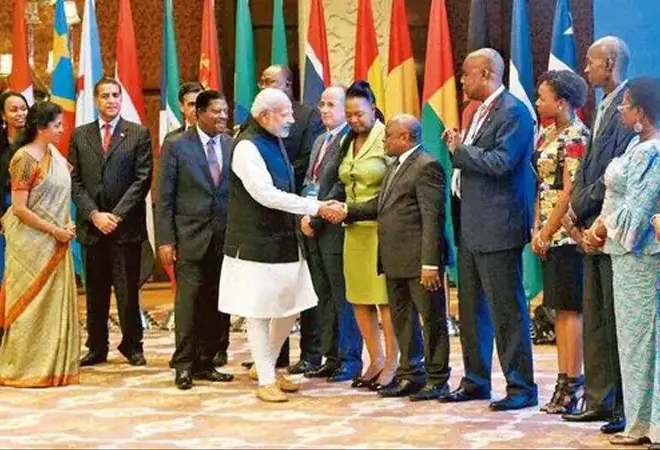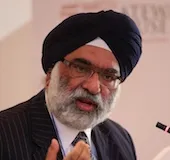-
CENTRES
Progammes & Centres
Location
India can work with regional financial institutions to expand successful Africa Summits, economic outreach, and improve LOC delivery through collaboration with RDBs

The time for the next India-Africa Forum Summit (IAFS IV) is getting closer. The first three were held in 2008, 2011, and 2015. The structure of the first two summits was based on the Banjul format— where India would invite only 15 heads of state or government through the African Union (AU), while IAFS III was on an all-Africa basis. There is a reasonable assumption that IAFS IV maybe in the Banjul format.
The AU convened the fifth Mid-Year Coordination Meeting (MYCM) between its members, the Regional Economic Communities (RECs), the Regional Mechanisms, and the AU Commission on 16 July 2023, showing the importance of the regional tier. The Banjul format recognises the three-tiered organisation of Africa and invites partners to cooperate on those levels. India had the best record in the initial years of pursuing a three-tiered cooperation through the African Union (AU), the RECs, and the traditional bilateral way.
The earlier results were not commensurate with Indian efforts. The AU often acknowledged that India was amongst the best partners in accepting Africa's three-tiered preferences. With the AU, India implemented the Pan-African E-Network project in 47 countries with considerable success. Subsequent efforts to offer Pan-African institutions through the AU did not succeed. The political choice of locations, and host countries not abiding by their responsibilities were the main causes.
Similarly, with the RECs such as the East African Community (EAC), Southern African Development Community (SADC), and Common Market for Eastern and Southern Africa (COMESA), India had a dialogue prior to IAFS in 2008. RECs were integral to the IAFS process and were invited on separate visits to India on three occasions by their Secretaries General and officials.
Implementation of the projects offered to them at IAFS II was dismal; most were cancelled when the rationalisation took place at IAFS III.
Against this backdrop, is it still worth suggesting collaboration with Africa through its regional institutions? This author believes so. This paper argues that this should be pursued strategically, engaging with efficient and responsive institutions rather than trying to re-engage with all RECs except at the IAFS.
The AU recognises eight RECs, who are the representatives of the regions in the Banjul format. Most of the RECs have regional financial institutions All of them should have standby brigades to intervene in regional crises. Their levels of efficiency vary vastly.
India is championing the AU’s membership of the G20, pursuing reform of multilateral development institutions (MDI), and is reinvigorating its Africa policy. As the India-Africa relationship finds new levels, it could seek determinants to further the relationship. The Lines of Credit-led model served India well, as it extended US$12.26 billion in soft loans to 42 countries. This is now unpopular because of debt stress, defaults, and countries opting out of debt.
A Foreign Direct Investment (FDI)-led model where the private sector takes the lead should be pursued. With US$75 billion of FDI in Africa, India is a major partner, particularly in key countries on the eastern seaboard of Africa, which is strategically important. The policy should look at supporting the private sector to overcome several issues they face in Africa because of the lack of support from Indian and local banks. The entrepreneurial spirit of the Indian private sector deserves acknowledgement.
The Harambee Factor, a recent book on the India-Africa partnership, highlights the role of Indian investors and how they raised the level of partnership between India and several African countries, often unnoticed. Now, India is better recognising the role of the investors. Investors feel that support is still slow.
The Africa Continental Free Trade Agreement (FTA) provides Indian companies with scope for larger regional markets in Africa. Many investors were waiting for this. They can scale up their operations and new players may like to enter. These companies require financial support, which is not coming from Indian banks, most of whom are retreating from Africa.
The LOCs empowered Indian companies to gain experience in Africa and bid for internationally-funded projects. Companies implemented transmission lines, railways, ports, logistics terminals, water, and renewable energy projects, funded by private institutions or by MFIs. Ports like San Pedro in Ivory Coast, Owendo in Gabon, and Nouakchott in Mauritania have Indian EPC contractors through such linkages.
Both the Indian investor and the Indian EPC contractor require opportunities, diplomatic support, and financial muscle to expand. This may be achieved by engaging with MDI in Africa. At the Pan-African level, Exim Bank invested in and provided LOC to the AfriExIm Bank—this should be intensified to support project exports and Indian EPC contractors in a determined manner. The Africa Development Bank (AfDB) is the World Bank-affiliated regional bank that has 54 African members and 22 non-African members, including India. However, India’s 0.265 percent stake is minor. There have been calls for India to raise its stake and acquire a separate director. However, with the last capital infusion in 2019, it is unlikely that this will happen in a hurry. Africa is now in everybody's sight. All countries holding stakes in the AfDB do not want to give them up. In 2020, Ireland worked hard to acquire a stake and ultimately had to get it from friendly countries. Stakeholders in the AfDB guard their share zealously.
India should establish a larger trust fund, provide the LOC-kind of funding, and use the professionalism of the bank to fulfil African priorities. Indian technology, goods, and services could benefit from AfDB’s larger resource mobilisation. India has had a trust fund of about US$9 million since 2015, to pursue Public-Private Partnership (PPP) models in Africa.
An Enhanced Private Sector Assistance Initiative will provide India with a larger role, obtain influence for Indian companies to avail other avenues of financing, and perhaps attain better results for their success.
Japan and Korea follow the AfDB model, because they are bilaterally weaker in Africa than India. India should work with the AfDB in a larger capacity than them. This calls for closer coordination between the Ministry of External Affairs (MEA) and the Ministry of Finance (MOF). The MOF is disinterested in the AfDB because it did not see any advantage accruing directly in terms of capital inflows. MEA must lead policy for the AfDB as it does for the LOCs. The AfDB-India partnership should reflect the vigour of the India-Africa partnership and not be fossilised at the levels of 1982, when the partnership began.
All the RECs in Africa don't function equally well, neither do the Regional Development Banks. The COMESA-affiliated Trade and Development Bank (TDB) has 25 members across Africa. This is among the best RDBs in Africa, professionally managed and accepting non-African states as partners. It remains open to having India participate in its financial holdings just as China and Belarus did. Arab Banks and African insurance and pension funds are its members too.
India has a US$100-million commercial credit available to the TDB, which it used rotationally without repayment problems. In the Harambee Factor, a survey of Indian businessmen showed Eastern Africa as their main focus for investment ahead. The TDB is the financial institution for that region. To support Indian entrepreneurs, access to TDB funding is important. India should become a stakeholder in the TDB, which welcomes an association. This is an opportunity worth grasping.
The 15-member ECOWAS has the ECOWAS Bank for Investment and Development (EBID), with powerhouses like Nigeria, Ghana, and Senegal within. The EBID has two windows, one to support public projects by member states and the other to support the private sector. EBID is not open to non-member stakeholding but it has US$1.5 billion in loans from the Exim Bank of India. In 2022, a US$ 100-million line to support the private sector was accorded. This was a step in the right direction. The Indian private sector is looking to enhance its footprint in West Africa, and have already worked with EBID through two-step loans. If India provides larger loans to EBID to support the private sector window, it will meet the goals of the private sector-led approach to Africa.
The improved performance of several African RDBs including their governance enhanced their market financing opportunities. Moody’s provides the World Bank-affiliated AfDB a AAA rating; TDB outlook is stable Baa3. EBID has a stable ‘B2 rating balancing its strong’ capitalisation against its higher credit risk. Afrexim Bank is stable Baa1with moderate risk.
Many ‘borrower-led MDBs’ are small but are growing rapidly. Potentially, they may have a larger role in dealing with world challenges, but do not get adequate recognition due to their size. They can achieve focused goals in Africa better as their management is aligned with the priorities of African countries, but they need larger funding to be more effective.
Can India think of bringing forth the State Bank of India which has branches in Africa or the LIC which has investments in Africa to invest in the RDBs? It appears that the tightening of regulatory controls would not favour such exposure in Africa by Indian banks and insurance companies. Whatever may be the debate around this, it brings the onus on sovereign entry into the AfDB, EBID and the TDB. The instruments will differ: Trust funds, private sector support, and a stake holding respectively.
India can enhance its engagement with regional financial institutions to build upon its successful Africa Summits, expand its economic outreach, and improve its delivery mechanism and success rate of LOCs by working with RDBs.
Gurjit Singh has served as India's ambassador to Germany, Indonesia, Ethiopia, ASEAN and the African Union.
The views expressed above belong to the author(s). ORF research and analyses now available on Telegram! Click here to access our curated content — blogs, longforms and interviews.

Gurjit Singh has served as Indias ambassador to Germany Indonesia Ethiopia ASEAN and the African Union. He is the Chair of CII Task Force on ...
Read More +